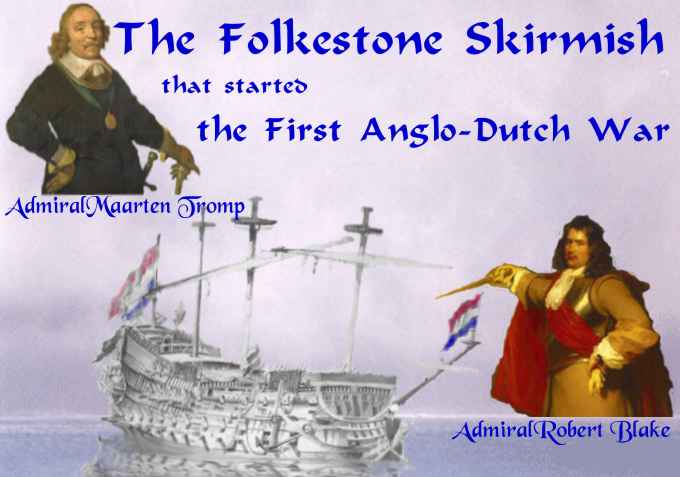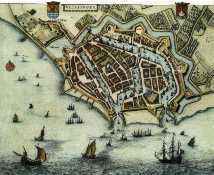The Anglo -Dutch Wars

| At
four o'clock in the afternoon of 19th May 1652, a small English Squadron
intercepted a convoy of seven Dutch merchant ships escorted by three
warships off Folkestone. The meeting resulted into a skirmish between
the Dutch Channel fleet of forty-two ships under command of Admiral
Maarten Tromp and twelve English ships under command of Admiral Robert
Blake this channel meeting of the two navies started the First Anglo-Dutch
War.
Some took the view at the time, that it was a premeditated attack by the Dutch fleet; others held the view that the conflict that started the war that was to last for two years was due to a misunderstanding by the two admirals. Admiral Tromp disclaimed that his intentions were aggressive; his sole object was to ask for the release of some Dutch merchantmen that he thought had been captured but had not. On his approach to Blake, he took in all his topsails, lowering them to the middle of the mast. He also declared that he had in fact sent a man to strike his flag but, as the pennant below had first to be hauled down, there was some delay, upon which the James fired two shots and then a broadside, to which he then replied. Admiral Blake’s version was that when the Dutch were within musket–shot, and they had lowered their flag, and as his duty being to insist that they do, he thrice fired a single shot to remind them of their manners. After the third round Tromp had given him a broadside and hung out a red pennant as a signal for his whole fleet to engage, as result of which Blake opened fire. After the fist exchange of broadsides, a stiff encounter ensued between the two flagships in which the rest of the fleets gradually joined. So began a five-hour channel battle as the fleet fought it out in what was to become the Battle of the Goodwin Sands. It was claimed that Tromp, sought to break off the fight when Nehemiah Bourne on board the Andrew, came down from the Downs to windward late in the afternoon, fell on his rear and partly cut it off from the main body. With darkness, falling Tromp retreated to the French Coast. The losses were heavy, onboard Blake’s’ flagship the James, her mizzenmast had been shot away and her sails and rigging blown to shreds, sixteen had been killed, and twenty-five wounded. Of Tromps’ fleet, one vessel became an English prize, while another that had been captured was so severely mauled that she was left derelict, as unlikely to reach port. Two of his Dutch captains were among the prisoners while fifty of their seamen were killed and a hundred wounded. The material result was thus in favour of Blake- for he had attacked superior numbers and remained in possession of the battlefield. From the tactical aspect the action redounded to his credit, for by bearing away towards the coast on the starboard tack he kept the greater part of Tromp’s fleet out of the battle for a considerable time, giving Bourne the chance of getting up and assailing their rear. At nightfall, the English anchored about twelve miles off Dungeness and on the following morning went in search of the enemy. Blake was anxious to purse the argument, but although the Dutch were sighted, no further clash took place. Traditionally England claimed sovereignty over the waters and seas surrounding Britain, under the Navigational Act of October 1651 the Parliament of the Commonwealth of England led by Oliver Cromwell required that all foreign fleets in the North Sea or in the Channel to dip their flag in salute to the English Navy. The Anglo-Dutch War began proper in July 1652 with an English campaign against the Dutch East Indies. Admiral Tromp returned to the Channel with 88 ships and attacked the 42 ships of Admiral Blake, and decisively defeated him at the Battle of Dungeness. The first Anglo-Dutch War was eventually was ended with the Treaty of Westminster signed on 5th April 1652, the Dutch acknowledging the English claim to a salute for the flag ‘in the British Seas’. |
||
|
Admiral
Tromp died on 10th August 1653; Admiral Blake died on-board his flagship
the George, on 7th August 1657. It was not long before the
Second Anglo-Dutch War started in 1664, which ended in 1667. A few years
later in 1672, the Third Anglo-Dutch War started that was to last until
1674. |
 |
|
|
A 1640 map of Flushing (Vlissingen), the harbour-city of Zeeland, Flushing has been an important harbour for centuries. It was granted city rights in 1315. In the 17th century Flushing was a main harbour for ships of the Dutch East India Company (VOC). |
||
| Folkestone had a town twinning link with Middleburg, and had a ferry service to Flushing which was started in 1911, but this service no longer runs, likewise other Cross channel services out of the Port of Folkestone, as there are no ferry services allowed to operate from the harbour as the owner will not allow them. The current owner seems to have no intention of allowing the cross channel ships into the port. Roger De Haan stated in the local newspaper the Folkestone Herald on 29th June 2006 that, “I have no interest in realising a profit from developing the harbour; I bought the land purely to secure a site for the university campus). Now that he has his university, he will not let Folkestone see the return of all of Folkestone's Cross channel services, including the Folkestone to Flushing route. |
||
|
June 1667, 'Raid on Medway'- Second Anglo-Dutch War: Wilkipedia link. |
||
|
The
Anglo-Dutch Trail > |
||